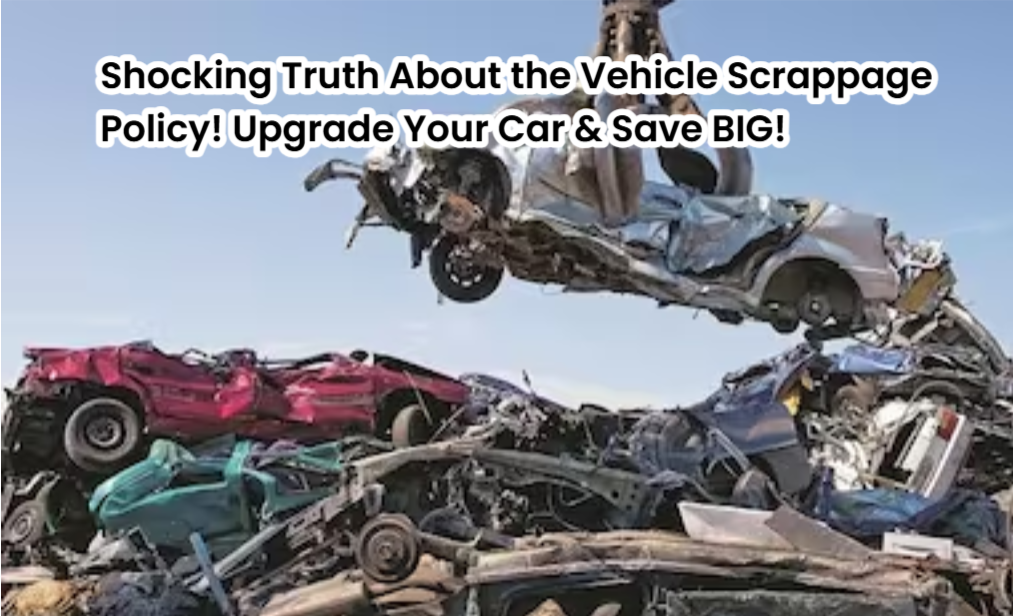Many of us have a deep emotional connection with our vehicles—whether it’s a car or a bike, we tend to hold onto them for years. As these vehicles get older, they become less efficient. They also pollute the environment by releasing more harmful gases. The Indian government launched the Vehicle Scrappage Policy in the 2025 budget. This aims to tackle the issue and promote a shift to cleaner vehicles. This policy aims to slowly remove old, polluting vehicles. It will help build a more sustainable automotive ecosystem.

What is the Vehicle Scrappage Policy?
The Vehicle Scrappage Policy is an initiative aimed at removing unfit, polluting vehicles from India’s roadways. The policy sets up a new way to manage private and commercial vehicles. It encourages getting rid of older models that don’t meet environmental standards. Vehicles will take a fitness test at approved testing stations and scrapping facilities. If they fail this test, they will be scrapped and removed from the central database of registered vehicles.
Under this policy, private cars over 20 years old and commercial or government vehicles over 15 years must pass a fitness test or be scrapped. This approach not only improves road safety but also plays a significant role in reducing pollution.
Key Highlights of the Vehicle Scrappage Policy
- Scrap Value Incentives: When vehicle owners scrap their two-wheeler or four-wheeler, they get 4-6% of the showroom price of their new vehicle. This incentive encourages the replacement of old, polluting vehicles with newer models.
- Registration Fee Waivers: Buy a new vehicle and show a valid vehicle scrapping certificate. You can get waivers on the registration fees. This makes the process of upgrading to a cleaner car more affordable.
- Tax Concessions: New vehicle owners can get tax breaks. They can save up to 25% on non-transport vehicles and up to 15% on transport vehicles for motor vehicle tax. These financial benefits make switching to newer, eco-friendly vehicles more appealing.
- Manufacturer Discounts: The government told vehicle makers to give an extra 5% discount. Buyers can get this when they show a scrappage certificate with their new vehicle purchase. This further incentivizes consumers to upgrade.
How Vehicles are Categorized Under the Scrappage Policy
The policy classifies vehicles into different categories based on their type and age:
- Government Vehicles: Vehicles owned by the central and state governments will be scrapped if they are more than 15 years old.
- Commercial Vehicles: All commercial vehicles must undergo a fitness test after 15 years. If they pass, they can be renewed for an additional 5 years; if not, they will be scrapped.
- Private Vehicles: Private cars must undergo a fitness test once they reach 20 years of age. Those that pass can have their registration renewed for 5 more years, while those that fail will be scrapped.
- Vintage Vehicles: Vehicles over 50 years old are classified as vintage and are currently exempt from the scrappage policy. These vehicles have sentimental or historical value. So, they are treated differently than regular ones.
Benefits of the Vehicle Scrappage Policy
The primary goal of the Vehicle Scrappage Policy is to protect the environment by reducing the number of old, polluting vehicles on the road. However, the benefits extend beyond environmental protection:
- Environmental Impact: Scrapping old vehicles helps cut air pollution. This leads to cleaner and healthier cities.
- Economic Boost: Phasing out old vehicles creates a demand for new ones. This boosts sales and profits in the auto sector. This, in turn, can lead to increased job opportunities in manufacturing, sales, and maintenance services.
- Financial Incentives for Consumers: The policy includes waivers, tax breaks, and discounts. These make it cheaper for vehicle owners to upgrade to newer models. This can lead to long-term savings on registration fees and taxes.
- Better Road Safety: Getting rid of old vehicles makes roads safer. This lowers the chances of accidents from vehicle problems or bad performance.
Making an Informed Decision
If you’re a vehicle owner considering the scrappage of your old car, it’s essential to weigh the benefits and incentives provided by the government. You can reduce pollution and enhance road safety. Plus, when you upgrade to a newer, efficient vehicle, you can enjoy financial perks like tax breaks and waived registration fees.
Before making a decision, consider these key points:
- Check Your Vehicle’s Condition: If your car is old and pollutes a lot, scrapping it might be a smart and responsible choice.
- Check the Incentives: Look at the financial benefits available. These include scrap value, tax breaks, and manufacturer discounts. They can help make upgrading cheaper.
- Plan for a New Vehicle: Use the scrap value and any incentives you have. Invest in a new car or a more efficient one that meets current environmental standards.
- Stay Informed: Policies and incentives can change. So, follow the latest government announcements and guidelines. This helps you make the best decision for your situation.
Final Thoughts
The Vehicle Scrappage Policy is a bold step by the Indian government to reduce pollution, boost the economy, and enhance road safety. The policy encourages getting rid of older vehicles. This helps the environment and gives money incentives for consumers to buy newer, cleaner cars.
As a vehicle owner, you have the opportunity to be part of this transformative initiative. Think about the good for the environment, the money you can save, and the safety improvements when you scrap your old car. Plan wisely and make informed choices. You can help create a cleaner, healthier India. Plus, you’ll enjoy the benefits of owning a modern vehicle.
Must read:
- Shocking Truth: The Best Maruti Car Insurance Plans You’re Missing Out On – Act Now!
- Shocking Truth About NCB Calculation in Motor Insurance – Don’t Miss Out on Huge Savings!
- Shocking Truth: How Insurance Can Save You from a Financial Nightmare!
